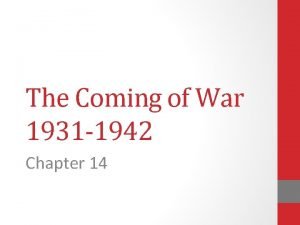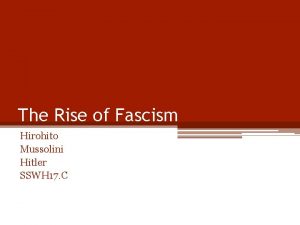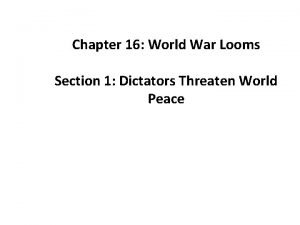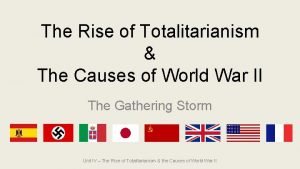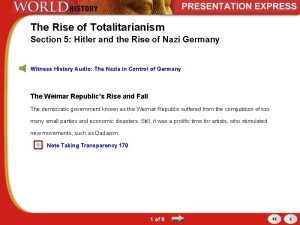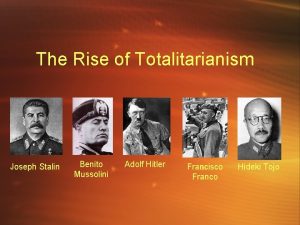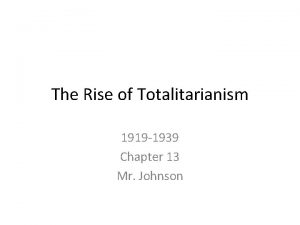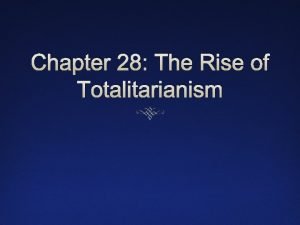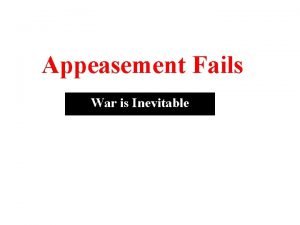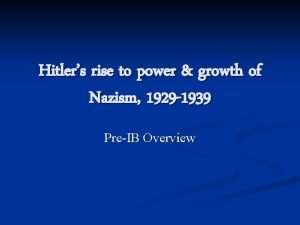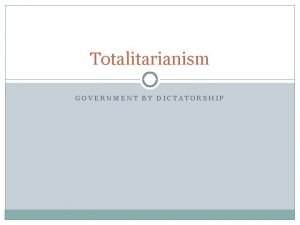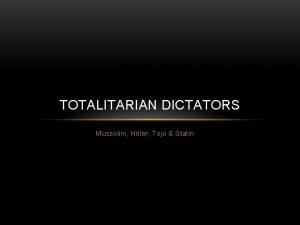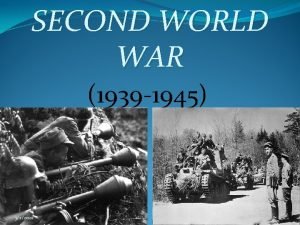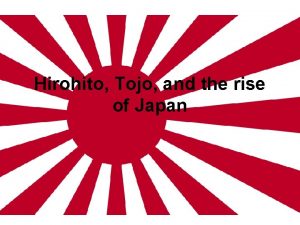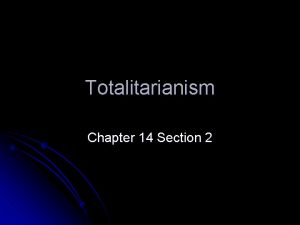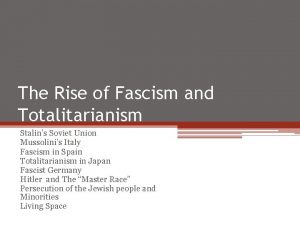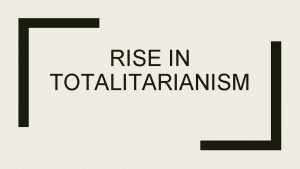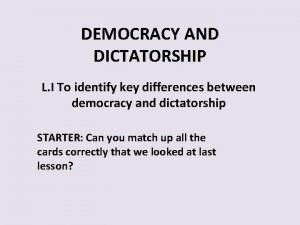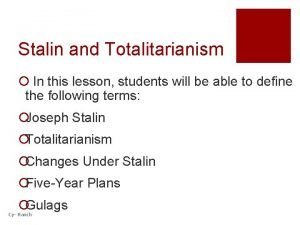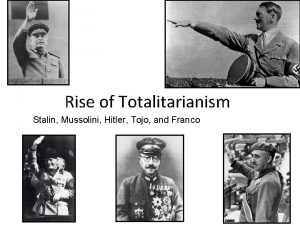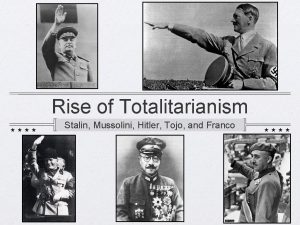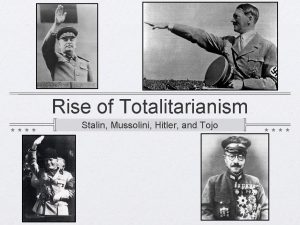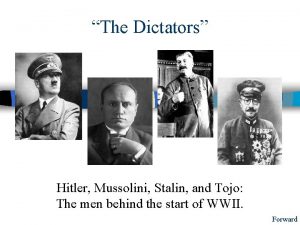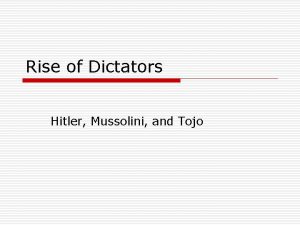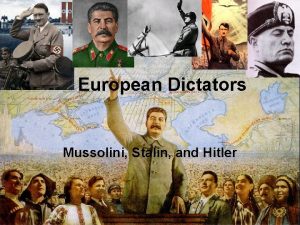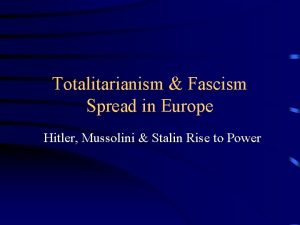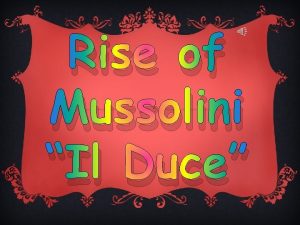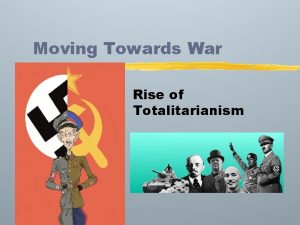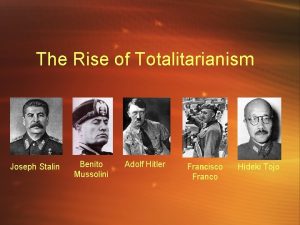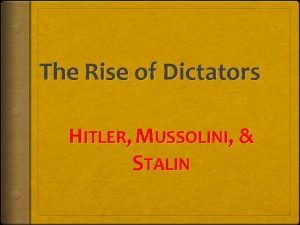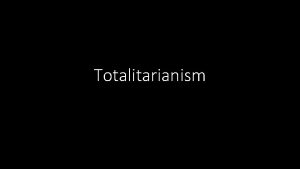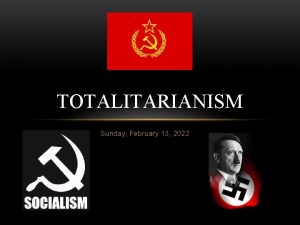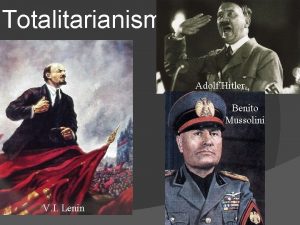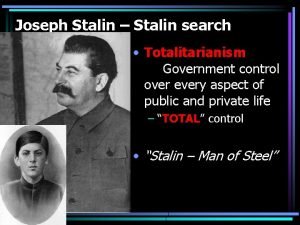Rise of Totalitarianism Stalin Mussolini Hitler and Tojo































- Slides: 31

Rise of Totalitarianism Stalin, Mussolini, Hitler, and Tojo

Rise of Totalitarianism A system in which the state and its leader have nearly TOTAL control. Individual rights are not viewed as important as the needs of the nation. No right to vote No free speech Government controlled economy Often a police state

Totalitarianism USSR: Communist Dictatorship Germany & Italy: Fascist Dictatorship Japan: Military Dictatorship

What is Fascism? • Political belief that says the individual is less important than the nation. • Glorifies violence, believes it is needed to “prove” strength of a people. • Nationalism: extreme pride for the state • Racism: use ethnic pride against other groups • Dictatorships: leaders take total control

Communism • A political, social, economic system where the government controls everythingmaking sure that all get what they need. (in theory) More extreme form of Socialism

Joseph Stalin – the brief version (1879 -1953) • 1924 Lenin died • Lenin wanted Trotsky to take over • Stalin took over instead. • Bullied / threatened / murdered his way into power. • Killed those loyal to Trotsky • Eventually has Trotsky himself killed. (Mexico 1940) • Stalin launched a massive program for industrialization (railroads, steel mills, military hardware), despite what it would require in human suffering. • Five-Year Plan to “catch and overtake” the leading capitalist countries.

Joseph Stalin After a terrible civil war and the death of Vladimir Lenin, Joseph Stalin took power in the Soviet Union. He immediately started putting his opponents to death and began a ruthless program to build up industry in the USSR, killing anyone who stood in his way! Problems The USSR was not industrialized and had a very weak military The Government was unstable after Lenin’s death. The economy was improving, but many still suffered from famine. Major Reforms Examples of Totalitarian Rule Collectivization of farms Single party dictatorship (Communist Party) Five year plans to industrialize USSR Ruled through fear and terror (Reign of Terror) Total Command Economy - government control all means of production Used censorship and propaganda - schools, newspapers, government Built up the military Secret police

Collectivization • He also started a revolution in Soviet agriculture forcing peasants to participate in collectivization. • This meant the pooling of farmlands, animals, and equipment for the sake of more efficient, and state-run, large-scale production. • Knowing that the well-to-do peasants (kulaks) would not accept this, Stalin decided to “liquidate them as a class. ” • Millions were killed outright or sent to forced-labor camps to suffer a slow death.

Purges • Many of the remaining peasants refused to go along, killing their herds and intentionally sabotaging their crops. • From 1931 to 1933, millions starved to death. • By 1935, practically all farming was collectivized. • To wipe out any remaining resistance, Stalin unleashed terror to crush opposition through a series of purges. • 750, 000 were executed between 1936 and 1938. • Those who were not executed were sent to forced labor camps, collectively known as the Gulag. • In the 1920 s and 1930 s, between 10 and 20 million people died as a result of Stalin’s policies.

Workers laboring in the GULAG work camp system

• From 1920 -1922, armed fascist squads faced minimal interference from the police or army as they roamed the country causing property damage and killing about 2, 000 political opponents. • On October 24, 1922, Mussolini threatened to seize power with a March on Rome. • thousands of his “Black Shirt” Fascist supporters captured the Italian capital to stop a fictitious Communist plot to overthrow the government. • King Victor Emmanuel III refused to declare a state of emergency, and instead gave in to Mussolini. Italy

Benito Mussolini and his fascist followers, known as the “Blackshirts” marched on Rome and seized power in Italy in 1922. Mussolini became Il Duce (“The Leader”) and set up an efficient but brutal rule over Italy! Examples of Totalitarian Rule Problems Major Reforms Economic and political problems (Debt, Unemployment, corruption). Developed Fascist party Extreme sense of nationalism Peasants lost land resentment after WWI Repaired and built up the infrastructure (roads, bridges, trains) Fear of communist uprising - Clear division between rich and poor Wanted to return Italy to the glory of the Roman Empire No criticism of state allowed! “Everything is the state” Forced Italian men to join military, women should have babies Used censorship and propaganda - schools, newspapers, government Secret police, the OVRA

Mussolini and his “Blackshirts” march on Rome in 1922 and take over government. The “Battle” for Births, Land, and Grain "War is to man what maternity is to a woman. From a philosophical and doctrinal viewpoint, I do not believe in perpetual peace. ” The Fascist State Invasion of Ethiopia

Balcony Speeches “Mare Nostrum” - Italian Expansion Libya - 1923 Greek Islands 1929 Ethiopia - 1935 Albania - 1939

WWI and the Treaty of Versailles • Germany lost land to surrounding nations • War reparations • Allies collect $ to pay back war debts to US • Germany pays $57 trillion (modern day equivalent) • Germans are bankrupt, embarrassed, guilt ridden, and angry. • Desperate people turn to desperate leaders

Nazism • Nazism (National Socialism) a political ideology promoting Germanic racial superiority. Held that the German nation and the purported "Aryan" race were superior to other races.

In Germany • Adolf Hitler comes to power in Germany by preaching socialism, nationalism, and militarism. • Hitler blamed the other European countries, and the minorities living in Germany for the poor German economy • Hitler’s party soon gained enough support so they could name him to office “One people, one empire, one leader!”

ADOLF HITLER • Brought prominence to the National • • Socialist German Workers Party (NAZI Party) Head of the 3 rd Reich Believed in Master Race – Aryan Race Unite all German-speaking people 1933 took power Anti-communist Private property with strong governmental control Das Fuhrer

Adolf Hitler In 1933 Adolf Hitler promised Germans that he would tear up the Treaty of Versailles. His Nazi Party won the elections and he was appointed Chancellor of Germany. He quickly gathered all power in his own hands and began arresting communists, trade unionists and Jews. Problems Major Reforms Examples of Totalitarian Rule Damage from WWI and Great Depression caused economy to suffer Developed Nazi party Extreme sense of nationalism Hyperinflation, unemployment, massive debt due to Treaty of Versailles Ignored Treaty of Versailles rebuilt military Developed idea of Aryans, master race, who needed to be purified and regain land that was rightfully theirs. Campaign against Jews Provided security and leadership to Germans Used censorship and propaganda schools, newspapers, government Fear of communist revolution Targeted scapegoats Jews, French, Communists Preached service to the state! Secret police, the Gestapo

Nazi Mythology “All within the state, none outside the state, none against the state. ” The Military State The Fascist State


Nazi Youth Movement Propaganda Posters

Imperial Japan • Japanese military leaders had increased control in post WW I Japan. • Emperor Hirohito • General Hideki Tojo was Prime Minister. • Admiral Yamamoto planned the attack on Pearl Harbor.

HIDEKI TOJO • Militant Japanese general • Took control of Japan in 1941 • Pushed for vast colonial empire stretching from China to Thailand • Organized attack on Pearl Harbor

Hideki Tojo During the Great Depression, nations could not afford to buy Japanese goods and many factories closed. Some Japanese blamed the democracy movement for the economic problems and thought that a return to military rule would be the solution to Japan’s problems. Problems Unhappiness over loss of traditions Loss of foreign markets due to Great Depression Unemployment, poverty among peasants Government was seen as weak, corrupt, and inefficient Major Reforms Military took over government and ended democracy Glorified war to build an over sea empire Stressed nationalism, shintoism, and antiwestern feelings Examples of Totalitarian Rule Preached service to the state and to honor Emperor Hirohito as a god! Invaded Manchuria and China Used censorship and propaganda - schools, newspapers, government Secret police

Invasion of Manchuria The Rape of Nanjing In 1937, the Imperial Japanese Army took over Nanjing, China and massacred an estimated 200, 000 to 300, 000 Chinese civilians. The Japanese army committed numerous atrocities, such as rape, looting, arson and the execution of prisoners of war and civilians. The Military State


Charismatic leaders Control of newspapers and schools and led massive youth movements

Replaces all political institutions with new ones and erases all legal, social, and political traditions Leaders are unpredictable, never allowing the people to feel completely safe New media technology used to spread propaganda

Directed violence controlled by the government becomes an important tool Stress of military power and expansion Police not limited by laws

Causes • W WI and the Treaty of Versailles • Appeasement • Rise of Totalitarianism
 Mussolini stalin hitler
Mussolini stalin hitler According to interventionists how would aiding
According to interventionists how would aiding Hirohito hitler and mussolini
Hirohito hitler and mussolini Chapter 16 section 1 dictators threaten world peace
Chapter 16 section 1 dictators threaten world peace Pearl harbor date
Pearl harbor date The rise of totalitarianism section 5 quiz
The rise of totalitarianism section 5 quiz Authoritarianism vs totalitarianism
Authoritarianism vs totalitarianism Chapter 13 the rise of totalitarianism
Chapter 13 the rise of totalitarianism The rise of totalitarianism section 1 quiz answer key
The rise of totalitarianism section 1 quiz answer key Hitler and stalin
Hitler and stalin Hitler stalin mao
Hitler stalin mao The rise and fall of adolf hitler
The rise and fall of adolf hitler Richard nixon tricky dicky
Richard nixon tricky dicky Nazi partys
Nazi partys How did hitler rise to power
How did hitler rise to power Rise and rise until lambs become lions
Rise and rise until lambs become lions Rise and rise again until lambs become lions
Rise and rise again until lambs become lions Rise and rise again until lambs become lions origin
Rise and rise again until lambs become lions origin Totalitarianism pros and cons
Totalitarianism pros and cons What evidence do you see of mussolini being militaristic
What evidence do you see of mussolini being militaristic Heideki tojo
Heideki tojo Hirohito/tojo
Hirohito/tojo Siketfajd lába
Siketfajd lába Mókus zápfog
Mókus zápfog Tomilho rastejante
Tomilho rastejante Chapter 14 section 2 totalitarianism
Chapter 14 section 2 totalitarianism Fascism vs totalitarianism
Fascism vs totalitarianism Onjectives
Onjectives Democracy vs. dictatorship venn diagram
Democracy vs. dictatorship venn diagram Pictoword for democracy
Pictoword for democracy Fascism vs totalitarianism
Fascism vs totalitarianism Totalitarianism lesson plan
Totalitarianism lesson plan

